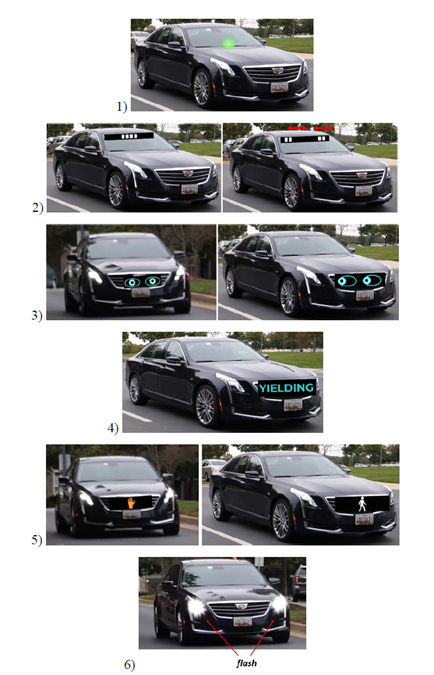Safety Impact of Interactions Between Vehicles Equipped with Automated Driving Systems and Shared Road Users Were Examined Through Structured Interviews, Field Visits and Simulated Tests.
Rockville, Maryland, United States
Automated Driving Systems’ Communication of Intent With Shared Road Users
Summary Information
Automated Driving Systems (ADS) have the potential to change the driving environment in many ways, particularly in the way drivers and other road users informally communicate with each other and how that applies to interactions between the ADS and other road users. The objective of this study was to understand the potential safety impact of interactions between vehicles equipped with ADS and shared road users. Three research studies were conducted as follows:
- In Study 1, researchers interviewed 10 recruited experts in driving evaluation and training to identify and characterize various signals and cues normally exchanged by road users under manual control conditions.
- The second study included field observations of cues used by drivers, pedestrians and bicyclists to predict intent of drivers. Forty participants were recruited from the Washington, DC area to perform think-aloud commentary procedures while engaged in travel through intersections, merged lanes, parking lots, and other locations where interactions between road users occur.
- In the third study, a preliminary laboratory-based protocol was developed with 30 participants to assess prototype external human-machine interface (eHMI) designs. Six different visual eHMI interfaces were developed and presented as video overlays that included the following range of communication approaches: 1) ADS Beacon, 2) Light Bar, 3) “I see you” eyes, 4) Yielding text, 5) Pedestrian WALK/DON’T WALK symbols, and 6) Headlamp flash. There were 29 unique trials in this study, each one a combination of an eHMI and a vehicle action (e.g., yield before crosswalk, drive through crosswalk).

- Make ADS vehicle movements more “readable” and consistent with existing road user expectations. Variation in vehicle driving styles may lead to difficulties in interpreting the intention of the driver behind the vehicle. ADS vehicles have the potential to create more standardized vehicle-movement cues that are easily interpretable.
- Replace traditional driver-related cues with vehicle-signalizing systems such as eHMI to better communicate intent with vulnerable road users. As pedestrians and cyclists currently rely more on driver-related cues over vehicle-signaling systems, it is important for ADS vehicles to assist them in identifying the intent without verbal communication or hand signals, since future ADS vehicles will not have a driver to provide such cues.
- Design eHMI that clearly and intuitively indicate intended vehicle action or suggested pedestrian action for highest comprehension. Training on the meaning of interfaces helped further enhance comprehension of all eHMIs. However, interfaces that were unfamiliar and unintuitive were unpopular, even after the meanings of the interfaces were explained. For example, the "don’t-walk" and "walk" icons were the most preferred interface for participants as these icons are universally recognizable.
- Design ADS vehicles with eHMI to interact with shared road users such as bicyclists that may be in close proximity. Driver related cues are used mostly when vehicles are in close proximity to shared road users, for example bicyclists who are concerned about being seen by nearby drivers often rely on eye contact and hand gestures. eHMI should be designed for such situations.
- Notify ‘yielding’ information as early as possible. It was found that participants could better comprehend the intentions of a yielding vehicle if the vehicle’s eHMI changed to its final state when it began deaccelerating rather than when it reaches a full stop. Participant feedback also suggested that earlier notification was preferred.
- Avoid binary options with confidence scales if using a survey approach to assess confidence perception of eHMI. Overconfidence ratings were found in this study as only bimodal options were provided. One potential way to address this overconfidence in future research is to provide participants with three distinct response options (i.e., yes, no, don’t know). Moreover, it is recommended to provide instructions that clearly and objectively delineate the different response options.
It is worth noting that the study results showed promise in potentially differentiating between different eHMIs for the single specific scenario involving a relatively simple crosswalk case; however, the generalizability of findings was not claimed.
